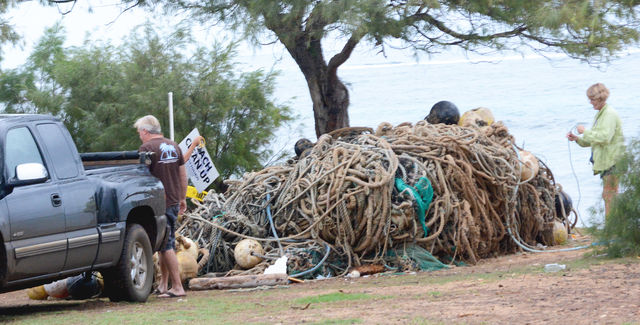KAPAA — Local scientists and volunteers said living things were found in the estimated 5,000-pound net found in the waters behind the Coral Reef Hotel in Kapaa Wednesday night. The state said otherwise. “As far as staff could tell, no
KAPAA — Local scientists and volunteers said living things were found in the estimated 5,000-pound net found in the waters behind the Coral Reef Hotel in Kapaa Wednesday night.
The state said otherwise.
“As far as staff could tell, no marine life was trapped…and not even barnacles were evident,” the Department of Land and Natural Resources said in a release on Friday.
Initial study of the creatures suggests the net might have come from an oyster farm in Japan, and could be part of the debris that has been washing ashore from the 2011 Fukushima disaster.
“I’ve found, among the ropes, little ropes with oysters stuck to them,” said Carl Berg, ecologist and member of Surfrider. “So I found some live oysters and some live anemones and some live bryozoans.”
Oyster farms often tie older oysters to their nets and that’s where the baby oysters settle, Berg said. Once the baby oysters grow large enough, they’re harvested.
“This is the first time on Kauai that I know of where we’ve actually found the oysters,” Berg said.
The significance of the discovery is that the oysters could be genetically tested to confirm suspicions that they’re from Japanese oyster farms, and they can be examined for parasites.
“They’re worried about invasive species coming in, and they’re worried the oysters have parasites that would come in,” Berg said.
He’s collected a few samples and is in the process of preserving them; and he’s notified experts in the fields of invasive species and marine debris, as well as DLNR.
The bill of a swordfish or a sailfish was also found tangled in the netting, according to Surfrider volunteers.
“We found an old rotten bill stuck in the nets and I can’t identify exactly what it is, but it’s one of the big fishes that got entangled and died,” Berg said.
The appearance of the net and its passengers reaffirms the Surfrider’s message that marine debris is deadly to sea animals, said Barbara Weidner, vice president of Surfrider’s Kauai Chapter.
“Whales can get caught in these kinds of nets,” she told onlookers as she helped saw pieces of the net out of the pile on Thursday afternoon. “It’s dangerous to all kinds of animals out there.”
And it’s not just the large-scale fishing nets that pose a threat to the animals in the ocean, said Robert Zelkovsky, and the best way to protect sea life is in daily life.
“These large net and plastic pollution influxes show we really have no control of what is happening in the ocean, (and) in other countries,” Zelkovsky said. “We do have control over what we eat and how we consume.”
He suggests eating less industrially caught fish and purchasing fewer products made with, or packaged in plastic as ways to reduce the amount of marine debris in the ocean.
The latest piece of marine debris to grace Kauai’s east side is now resting at Restore Kauai in Kapaa thanks to the Department of Land and Natural Resources’ Division of Boating and Ocean Recreation.
Staff from DLNR’s Kauai DOBOR office first learned about the net on Wednesday evening via a post on social media, according to the DLNR release. It was moved and secured onto land Thursday morning after an on-site assessment by Kauai DOBOR district manager Joseph Borden.
The net was removed from the beach area less than 48 hours after DLNR found out about it, according to Deborah Ward, spokeswoman from DLNR.
“Two sizable, heavy trucks with chains were required to roll the partially burriend in sand net mass above the high was of the waves and onto the property of the Coral Reef Resort hotel,” the DLNR release said. “The net mass will be shipped to Oahu for recycling/disposal.”
And scientists are planning to cut into the net and see if anything else has been trapped inside.
“It’s impossible to get to the center of it (the net) right now because the ropes are all wet and it’s impossible to dig in it,” Berg said. “After they’ve lifted it up and shuffled it around we can continue to look for stuff.”


